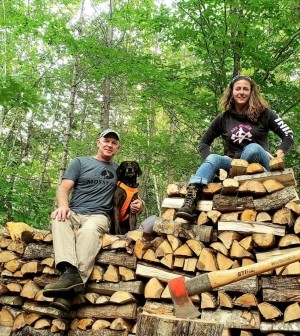
Alissa Wetherbee grew up exploring and working in the woods on Maine’s Mount Desert Island – home of Acadia National Park. In her early 20s, Alissa discovered logging sports competitions and began entering them. She was one of very few women at the time to compete in axe throwing, chopping, and other events. She founded Axe Women Loggers of Maine in 2011 to encourage other women, showcase their athleticism, and celebrate the heritage and history of lumber sports. The group puts on shows – part entertainment, part competition – across North America. Beyond their prowess in lumber sport events, team members must also fit the requirements, outlined on the team’s website, of being “strong in spirit and mind, adventurous, tenacious, notable in their achievements, and respected role models in their chosen profession.”
I was definitely the kid who was off with my dog, playing in the woods until dark. I’d hear my mom yelling for me and see the flashlight beam looking for me to come home and have dinner. I spent so much time just walking through the woods and playing in streams, poking at trees, looking for salamanders and tree frogs. And I can still do it today – just go wandering off into the woods and totally lose track of time.
One of my favorite things was helping my family with firewood. I grew up in an older farmhouse on the island that my parents had gutted and renovated. We didn’t have a furnace. We had an old-fashioned big wood-burning cookstove in the kitchen that heated the house. We would go through 7 or 8 cords of wood in the winter. My dad is a caretaker for a lot of properties around the Pretty Marsh area. There is often storm damage, and one of his jobs is keeping the roads clear – I don’t think he ever had a shortage of firewood. In the summer, I would go out in the woods with my dad and help cut trees. We would end up with a mountain of firewood in the driveway. My dad would cut it and split it, and my mom and I would put it into wheelbarrows and bring it to this extension to the barn that was just for storing firewood. My mom and I would stack it until it was waist high, and then she would lift me up so I could stack it higher. It was packed, floor-to-ceiling, wall-to-wall.
They used to air lumber sport competitions on ABC’s Wide World of Sports. Occasionally you’d see girls log rolling, but other than that, it was men. They’d be climbing the poles and chopping logs. I thought it was kind of cool that this was a sport – and that it was mainly stuff that I already did. I played sports growing up and did track and field in high school. I was growing up in the woods and working in the woods with my dad, so I was doing things that weren’t the normal “girl” things, maybe. And lumber sports looked interesting.
When I was about 20, I realized I could get into the sport. At that point, I had learned how to run a chainsaw, and I was cutting down trees with my dad, who was also doing small scale pulpwood with the softwoods that would blow down. We would save the firewood out, but we would cut the pulpwood to length and haul it out and stack it up on the side of the road for the big pulp truck to get every spring. I realized that the local fairs had a woodsmen’s day or a woodsmen’s competition, and that involved running a chainsaw.
Twenty some years ago, there were very few competitions for women. I started going to the woodsmen’s competitions, and I would be the only woman other than the competitors’ wives, who were there to do the Jack and Jill competition, which is a man and a woman on a crosscut saw. We were allowed to compete, but we didn’t have competitions of our own. The competitions I could win were the chainsaw events and axe throwing. If you’re chopping a log – there is a lot of technique involved, but a bigger man is going to be faster and stronger on most chopping events than a woman. That’s just the way it is. That’s not to say that a woman can’t beat a man. I competed in all of the events and rarely won chopping events, but I definitely took my fair share of wins in axe throwing and chainsaw events.
Eventually, the organizers saw that there were more and more women getting involved. Now, most competitions do have women’s events. Depending on how far you want to travel, you could find a competition every week, all year long. But that’s if you want to spend your winters in Australia and New Zealand and travel throughout the U.S. the rest of the year. The Lumberjill World Championships are in Boonville, New York, every August. Once the competitions started shifting to having more women’s events, I noticed that by 6 o’clock in the morning the grandstands were packed with people waiting to watch the women’s competition – which didn’t start until the afternoon. People were really interested in seeing the women’s competitions.
There are tons of lumberjack shows out there. If you’ve seen one, you’ve seen them all. They’re all based off of one family’s show from the 1970s – the same lines, the same corny jokes. It’s all kind of based of making fun of lumberjacks. They’re wearing corny outfits and suspenders, and it’s a very scripted show.
We wanted to show the other side of it – that we’re not wearing frumpy clothes and suspenders – this is actually a professional sport. These women are professional athletes. And it’s a heritage sport. There’s no need to make fun of it. People are genuinely interested in the history of why we do each of the events we do. Crosscut sawing, for example, came from felling a tree with a crosscut saw. The underhand chop came from having to size the logs down to manageable lengths to haul them out of the forest. Log rolling came from the log drives down the river to get the logs to the mill. Everything we do actually came from a job that lumberjacks were doing. People are super interested in that history.
Our shows are 30 to 40 minutes long. My husband, Mike, is the announcer. He gives a little bit of the history. As we’re getting ready for the event, he’s letting people know about the tools we’re using and how they came to be. They really haven’t changed a ton over time. The crosscut saws are now cut out with a laser, but they’re still hand-filed, and if you look at them, they’re pretty much the same as they were hundreds of years ago. We always have people who come up after the shows, and they want to share these cool family stories about their grandfather or great-great-grandfather who was a lumberjack.
And we don’t need to stage it. Even though it’s a show, and we’re a team, it’s very much an individual sport. The ladies on the team are all on that level of being on that competitive stage, and they don’t want to lose to each other. No one’s ever losing the chop because they’ve already won two events, and that’s what the script says. At the end of the day, it’s bragging rights for us, and it’s great training. We have 38 ladies on the Axe Women team. Most of them are world champions, world record holders, collegiate champions, or up-and-comers in the timber sports world. They’re amazing athletes. But, more than that, they’re just incredible role models in their communities, in their careers. We have doctors, lawyers, scientists, law enforcement officers, veterinarians.
When we started Axe Women, it was six ladies from Maine. We realized quickly that we were booking up so many shows that we were going to burn everybody out. We started branching out. Now we have ladies from Florida and Montana and British Columbia – all over. There are usually four athletes on each show. Mike and I will do all the travelling and most of the set up. We have two full trailers of equipment available and on the road all the time. We have four swimming pools, four log rolling logs, close to 50 throwing axes, close to 20 chainsaws. Our logrolling pool is 20-by-20 and 4 feet deep, 7,000 gallons. Very rarely does a venue actually have a body of water for us to use. We usually get there a day or two ahead of time to do all the set up. The other ladies will drive or fly in the night before. In the spring, I’ll blast out the schedule to all the girls, and they’ll pick the events that work with their schedule.
We start off every show with an event called Hot Saw. It’s a loud, souped up, modified chainsaw. We race to see who can make three cookies – a disc off a log – fastest. We compete in axe throwing, which is throwing a real, double-bitted axe at a target. We compete with old-fashioned cross-cut saws. We do a couple of chopping events. One is the underhand chop, where you’re standing on top of a log and chopping it in half between your feet. You chop halfway through on one side, then spin around and chop halfway through on the other. The other is called standing block or vertical chop, where the log is upright in a stand. This is like the act of cutting down a standing tree with an axe. You’re swinging at it as if you were hitting a baseball. You make a V in it – you make two upswings and two downswings. Similar to the other chop, you chop halfway through and then run around and chop halfway through the other way.
Most of our shows end with the crowd favorite of log rolling. That’s two girls on a log in the pool. All the events are exciting in their own way, but people love seeing someone fall in the water. The log roll competition is usually the best out of three or the best out of five tries. You’re trying to knock the other person off. Basically, the only rules are that you can’t touch the other person, and you can’t cross the center line on the log. You can run backwards, forwards, jump up and down on the log, kick water in the other person’s face.
For years, we competed with and traveled with a 600-pound western red cedar log, which isn’t the easiest thing to travel around the country with. Several years ago, a lady in Minnesota and her mom, who are world champion boom runners and log rollers, created a synthetic log. It weighs 60 pounds empty. You throw it in the pool and fill it up with water, and then it weighs as much as a log. When you buy a log, you get paddles you can put on it – she calls them training fins. It’s kind of like a paddlewheel on a paddlewheel boat. We don’t need these fins for a show, but we realized early on that if you put them on, you can use the log to travel. We bought one of these logs to try it, and we were driving out to Nebraska for a show and stopped at this little place called the Riverview Roadhouse in Le Claire, Iowa, right on the Mississippi River. At some point that night, Mike looked out over the river and said, “Do you think you could log roll across that?” That turned into a year of planning.
When we started training for it, we were throwing a log in the ocean off of Pretty Marsh on MDI and log rolling across coves, because I needed something with waves and a current. I’d always log rolled in a pool or a pond. I would spend two hours on the log, going back and forth across the cove and practicing getting on in water over my head. I had no idea how long it would take to cross the Mississippi from Port Byron, Illinois, to Le Claire, where the river is a mile across.
We were there a day and a half ahead of time, and there were crazy floods and whitecaps on the river. The night before, we walked down to the river, and full dumpsters had been pulled out of people’s parking lots, and they were just floating by. There were 60-foot trees tumbling by in the river. The morning we went out to do it, it was calm and perfect, no wind, everything just lined up. Mike and my dad were in a canoe beside me. We had realized early on in our training that I could control going backwards and forwards, but if the current got me, it would pretty much swing the log. We had to have a tether to the canoe, so they could apply pressure occasionally just to keep the log straight. It took me just over 29 minutes to cross.
We started a program during the pandemic called the Axe Women Pathfinders. We had met so many women over the years who had told us they love watching us and love what we’re doing, and maybe they didn’t grow up in a family that did lumber sports or go to a college that offered it as a sport. During events, we often invite people in to try axe throwing or other things, and sometimes these ladies just have a natural ability and are good at one or two of the events. They’re interested in learning the events and the sports and the history. They train with the team. They’ll travel with us. They’re learning from world champions. Last year one of our Pathfinders actually competed in her first professional competition.
We’re all big tree huggers. A lot of people will read an article about timber sports and comment about cutting trees down. We are not out there slaughtering trees for the fun of it. Even here, all of our firewood comes from storm damage and blowdowns. The same goes for our business. We have in our contract that the venue has to supply wood, but we give them places to get it from. For the most part, we’re chopping poplar and cottonwood. Most tree services are clearing this wood from utility lines or from the side of the road. This is wood that has to come down for one reason or another and otherwise would be put through a chipper. We are very picky about that. We don’t want someone going out and chopping down a bunch of beautiful trees for us to use in our show.
The Maine Forest and Logging Museum contacted me in 2017 and asked if Axe Women wanted to do demonstrations there during the summer. It’s such a cool place, and only an hour away, but I hadn’t been there. It’s 500 acres, just a few minutes outside of Bangor. There are working sawmills powered by waterwheels, so there’s a millpond. There’s a beautiful stream running through it, and a blacksmith shop. There are two operational Lombards – a train engine that runs on caterpillar tracks and used to pull loads of logs out of the woods. They were made here in Maine. We fell in love with the place, and then we were invited to be on the board. A lot of our time, when we’re not in Axe Women world, we’re in museum world and thinking about what we can do to get more people going and to get the word out about it.


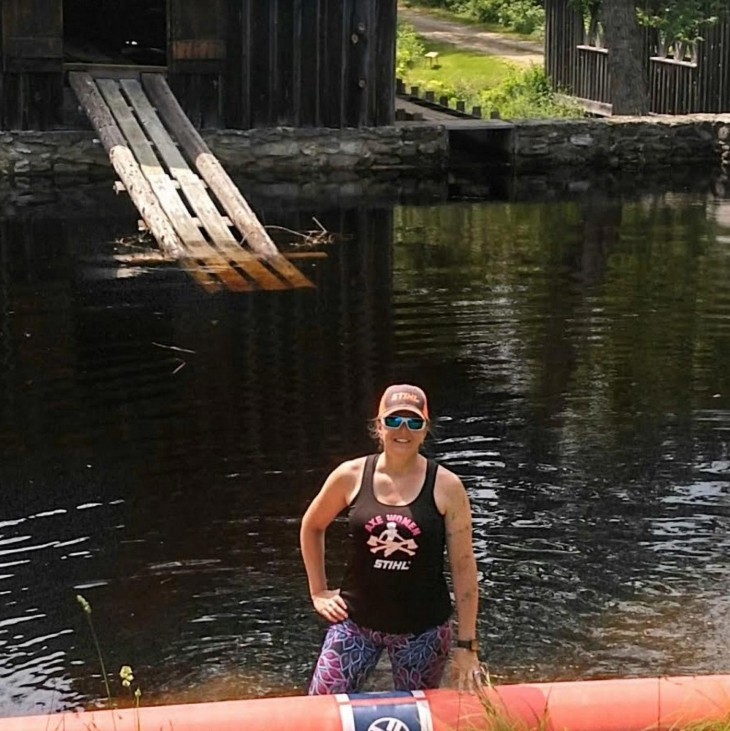

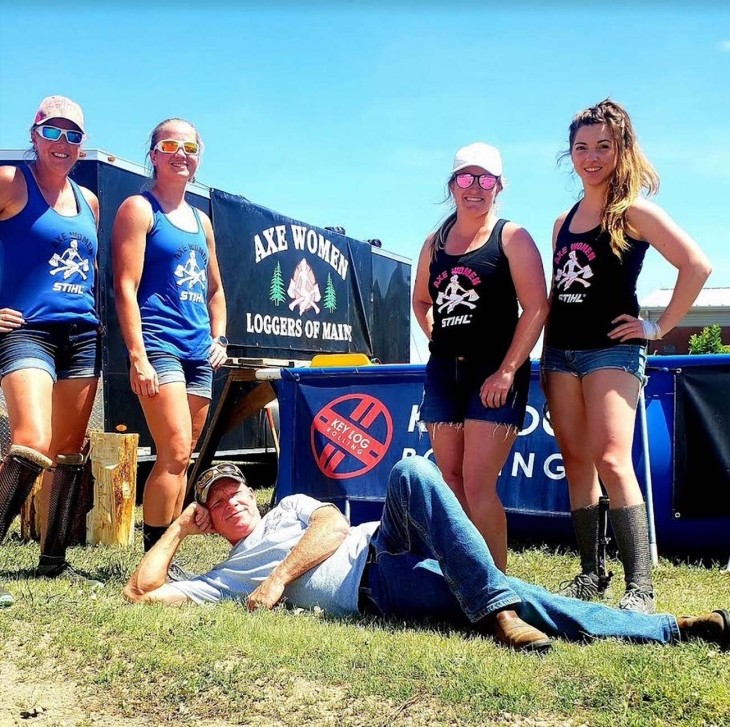
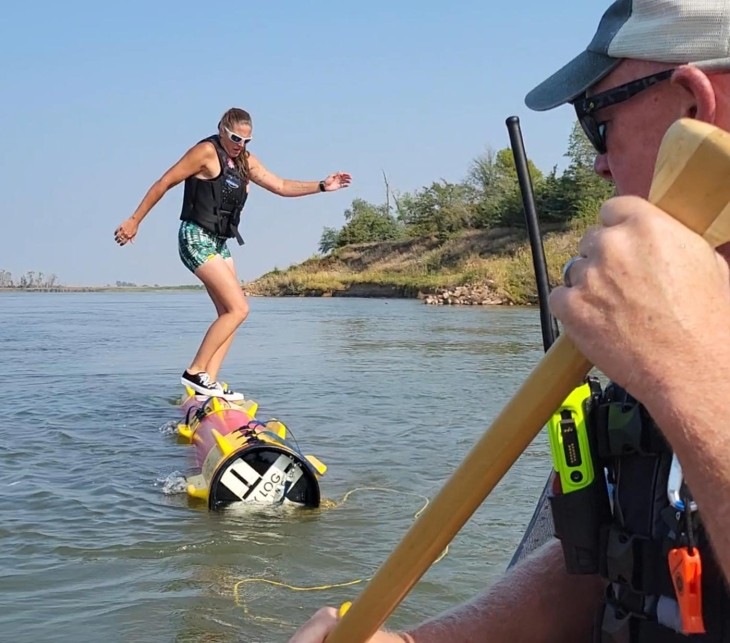
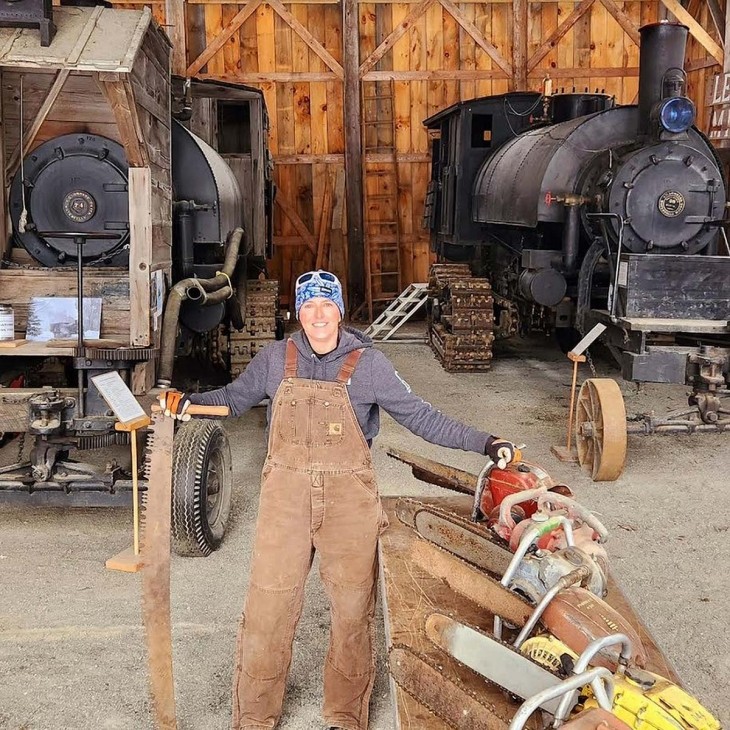
Discussion *